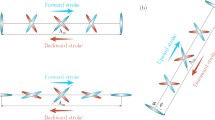Abstract
We studied modulations of flight activity in European grapevine moth females (EGVM) by individual observations in a wind tunnel. The effect of different factors was analyzed: variation in atmospheric pressure prior to the experiments, time of day, first experience of flight, age, mating, and odor of tansy, which attracts females. The circadian flight activity showed a peak the hour preceding the onset of scotophase and sustained activity occurred during the 6 h around this peak. Females with a flight experience in the tunnel took off more quickly than naive ones (3.9 ± 7.4 vs 20.3 ± 22.8 s). Three-day-old unmated females subjected to negative variations of atmospheric pressure (10 hPa) during the 4 h prior to the experiments increased their duration of flight (12.1 ± 8.7 vs 5.3 ± 3.4 s) compared to those not subjected to variation. One-day-old females were less active than older ones; flight was shorter than in 2-day-old females (2.7 ± 6.7 vs 5.1 ± 9.5 s) and fewer of them took off (28 vs 63%). Mating also affected the flight activity of 2-day-old females; mated females flew longer than virgins (12 ± 16.8 vs 5.1 ± 9.5 s) and took off more quickly (6.5 ± 14.4 vs 19.3 ± 20.1 s). Tansy odor in the tunnel did not significantly affect the flight behavior of virgin females, but it increased the proportion of mated females that initiated flight (87 vs 70%) and duration of flight (11.2 ± 24.4 vs 7.2 ± 13.7 s), and it reduced the latency to takeoff (2.1 ± 7.4 vs 8.1 ± 19.1 s). Flight duration in tansy odor was inversely correlated with the total number of eggs laid during the female's whole life. Our experimental settings did not allow observation of movements directed toward the odor source.
Similar content being viewed by others
REFERENCES
Arn, H., Rauscher, S., Guerin, P., and Buser, H. R. (1988). Sex pheromone blends of three tortricids pests in European vineyards. Agr. Ecosyst. Environ. 21: 111–117.
Barton Browne, L. (1993). Physiologically induced changes in resource-oriented behavior. Annu. Rev. Entomol. 38: 1–25.
Bell, W. J. (1981). The influence of light cycle and circadian rythm on oviposition in five pyralid moth pests of stored products. Physiol. Entomol. 6: 231–239.
Bovey, P. (1966). Super famille des Tortricidae. In Ballachowsky, A. S. (ed.), Entomologie appliquée à l'Agriculture, Vol. 2(1), Masson, Paris, pp. 456–893.
Campan, M. (1977). Etude du comportement d'orientation des femelles de Calliphora vomitoria (Diptères) vers l'odeur du lieu de ponte. Mise en évidence du rôle de l'ovaire. Gen. Comp. Endocrinol. 31: 422–450.
Chaboussou, F., and Carles, J. P. (1962). Observation sur le piégeage sexuel des mâles d'eudémis (Lobesia botrana Schiff.). Rev. Zool. Agr. Appl. 61: 81–98.
Dembitskii, A. D., Krotova, G. I., Yurina, R. A., and Suleeva, R. (1984). Composition of the essential oil of Tanacetum vulgare. Khim. Prir. Soedin. 6: 716–720.
Gabel, B. (1992). Tansy flowers attracts European grapevine moth females, Lobesia botrana Den. & Schiff. (Lepidoptera, Tortricidae). J. Appl. Entomol. 113: 153–158.
Gabel, B., and Thiéry, D. (1994). Non-host plant odor (Tanacetum vulgare; Asteraceae) affects the reproductive behavior of Lobesia botrana Den & Schiff. (Lepidoptera: Tortricidae). J. Insect Behav. 7: 149–1576.
Gabel, B. Thiéry, D., Suchy, V., Marion-Poll, F., Hradsky, P., and Farkas, P. (1992). Floral volatiles of Tanacetum vulgare L. attractive to Lobesia botrana Den. & Schiff. females. J. Chem. Ecol. 18: 693–701.
Götz, B. (1941). Beiträge zur analyse des Mottenfluges bei den Traubenwicklern Clysia ambiguella und Polychrosis botrana. Weinu. Rebe 23: 207–228.
Howlader, M. A., and Gerber, G. H. (1986). Effect of age, egg development, and mating on calling behavior of the berta armyworm, Mamestra configurata Walker (Lepidoptera: Noctuidae). Can. Entomol. 118: 1221–1230.
Klowden, M. J. (1990). The endogenous regulation of mosquito reproductive behavior. Experientia 46: 660–670.
Kumar, H., and Saxena, K. N. (1985). Oviposition by Chilo partellus (Swinhoe) in relation to its mating, diurnal cycle and certain non-plant surfaces. Appl. Entomol. Zool. 20: 218–221.
McNeil, J. N. (1991). Behavioral ecology of pheromone-mediated communication in moths and its importance in the use of pheromone traps. Annu. Rev. Entomol. 36: 407–430.
Miller, C. A., and McDougall, G. A. (1973). Spruce budworm moth trapping using virgin females. Can. J. Zool. 51: 853–858.
Roitberg, C. A., van Alphen, J. J. M., and Mangel, M. (1993). Life expectancy and reproduction. Nature 364: 108.
Scherrer, B. (1992). Biostatistique, Gaëtan Morin Editeur.
Schmitz, V., Roerich, R., and Stockel, J. (1995). Disruption mechanisms of pheromone communication in the european grape moth Lobesia botrana Den. & Schiff. (Lep. Tortricidae) II. Influence of the population density and the distance between insects and the distance between insects for males to detect the females in athmosphere impreganted by pheromone. J. Appl. Entomol. 119: 303–308.
Siegel, S. (1956). Nonparametric Statistics for the Behavioral Sciences, International Student ed., McGraw-Hill International Book, New York.
Stockel, J., Roerich, R., Carles, J. P., and Nadaud, A. (1989). Téchniques d'élevage pour l'obtention programméed' adultes vierges d'eudémis. Phytoma 412: 45–47.
Stoeva, R. (1982). Les hôtes de l'Eudémis (Lobesia botrana Schiff.) en Bulgarie. Gradin. Lozar. Nauka 19: 83–89.
Witzgall, P., and Arn, H. (1990). Direct measurement of the flight behaviour of male moths to calling females and synthetic sex pheromone. Z. Naturforsch. 45: 1067–1069.
Author information
Authors and Affiliations
Rights and permissions
About this article
Cite this article
Hurtrel, B., Thiéry, D. Modulation of Flight Activity in Lobesia botrana Den. & Schiff. (Lepidoptera: Tortricidae) Females Studied in a Wind Tunnel. Journal of Insect Behavior 12, 199–211 (1999). https://doi.org/10.1023/A:1020914800170
Issue Date:
DOI: https://doi.org/10.1023/A:1020914800170




